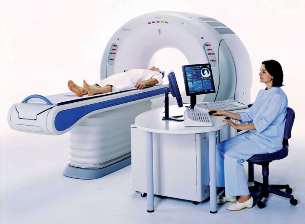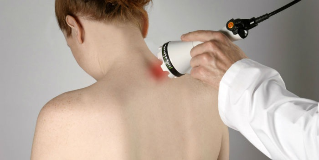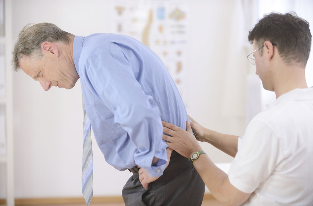
Osteochondrosis of the cervical spine is a serious pathology characterized by degenerative-dystrophic changes in the structure of the intervertebral discs. This disorder often leads to dangerous complications. Therefore, it is strictly forbidden to ignore it. To cope with an illness, it is worthwhile to consult with a specialist in a timely manner.
Essence of pathology
Osteochondrosis of the cervical spine is a pathology in which the soft intervertebral pulp is transformed into bone tissue. This causes pinching of blood vessels and nerve fibers.
Pain syndrome is a characteristic feature of the disease. It is localized in the neck, shoulders, upper back, head. Many patients experience dizziness, pressure fluctuations, nausea, and lack of air.
Dystrophic changes in the cervical region usually occur in middle and older age. This is due to the vertical position of the skeleton and the peculiarities of the distribution of loads.
Doctors note that the disease occurs earlier in men. This happens at 45-50 years old. Women face manifestations of cervical osteochondrosis later - at the age of 50-55.
Reasons
Various factors lead to the development of this form of the disease. The main causes of cervical osteochondrosis include the following:

- Lack of physical activity. In people who are inactive, there is a depletion of the back muscles that support the spine. This situation can be aggravated by the deposition of salts that appear due to lactic acid. A weakened spinal column deforms more easily and becomes less mobile.
- Obesity. The appearance of excess weight is a great danger to the musculoskeletal system. In addition to increasing stress on the spine, adipose tissue takes away useful substances that are required to maintain the tone of muscle tissue and cartilage.
- Prolonged immobility. This disease is common in drivers and people who are engaged in intellectual work. After a long stay in a compressed state, the cartilage tissue gradually loses its elasticity. Over time, the intervertebral discs acquire an unnatural configuration.
- Eating disorders. For the body to function properly, the diet must contain sufficient proteins, fats, minerals and vitamins. Inappropriate nutrition provokes a violation of the structure of tissues and leads to their rapid destruction.
- Injury to the back. This can cause a redistribution of pressure on the cartilage tissue, which provokes a change in their structure and shape.
- Pathologies of the musculoskeletal system. This category includes scoliosis, rheumatism, bone tuberculosis.
Cervical osteochondrosis is often the result of a hereditary tendency. In this case, the pathology develops without the influence of significant factors.
To prevent the onset of the disease, it is necessary to start therapy in a timely manner.
Disease stages
There are several stages of pathology, each of which is characterized by certain features:
- First, the key sign of the condition is spinal instability. It manifests itself in the initial lesions of the intervertebral discs;
- Second, protrusion is the main manifestation. This condition is characterized by a decrease in the gaps between the vertebrae, a gradual disruption of the integrity of the annulus fibrosus. Nerve compression pains often occur;
- Third - at this stage, the annulus fibrosus is completely destroyed. This leads to the occurrence of an intervertebral hernia. This condition is characterized by severe damage to the spine;
- The fourth is the most difficult. At this stage, with any movement, acute pain occurs. Sometimes the condition improves, but this indicates the appearance of bone structures connecting the vertebrae. This results in decreased physical activity and disability.
Symptoms

This form of osteochondrosis is characterized by special manifestations. This is due to the close location of the cervical vertebrae and the low height of the discs. Therefore, even small changes provoke serious manifestations. In addition, this form of osteochondrosis is often accompanied by compression of the spinal roots.
Cervical osteochondrosis symptoms include the following:
- Painful sensations. They are localized in different areas - the back of the head, neck, shoulder girdle, arms. Discomfort in the arms or shoulder girdle is caused by pinched nerves. Pain in the occipital region is associated with spasms of the muscle tissue of the neck and poor circulation.
- Weakness in the arms. This symptom is caused by damage to the motor nerves responsible for the innervation of the muscles of the arms.
- Weakening of sensitivity in the hands. This symptom is due to the defeat of the roots, which include sensory fibers responsible for the innervation of the skin of the hands.
- Decreased neck motor activity, crunching appearance. Such symptoms of cervical osteochondrosis are the result of a decrease in the height of the discs. They are also caused by damage to the intervertebral joints and the formation of bone growths on the vertebrae.
- Weakness, loss of coordination and dizziness. These manifestations are caused by damage to the vertebral artery. The formation of fibrous tissue and displacement of the vertebrae provoke problems with blood flow in the arteries. As a consequence, there is a deterioration in blood flow in the occipital region of the brain and cerebellum.
- Hearing impairment, tongue numbness, weakening of visual acuity. These symptoms of osteochondrosis of the cervical spine are caused by the aggravation of the situation and the progression of cerebral circulation disorders.
Diagnostic methods
To identify osteochondrosis of the neck, a number of diagnostic procedures need to be performed.The most informative studies include the following:

- Magnetic resonance imaging is the most informative study that allows you to assess the condition of the vertebrae and discs between them. Also, using this procedure, it is possible to detect hernias, assess their size and localization.
- Radiography - This procedure is one of the most widely available research methods. However, it often becomes uninformative, especially in the last stages of the disease.
- Computed tomography - allows you to identify the presence of changes in the structure of the vertebrae. However, the presence of a hernia or spinal cord compression is difficult to diagnose this way.
- Duplex Ultrasound - Helps to detect blood flow abnormalities in the vertebral artery. The procedure detects obstructions and slowing down of blood flow in the vessels.
Treatment methods
Treatment of cervical osteochondrosis is selected taking into account various factors. This is done depending on the stage of the disease, the form of the disease, the severity of the symptoms.
Key therapies include the following:
- Conservative therapy - can be medication and non-medication;
- Surgery;
- A combination of conservative techniques and surgical treatment.
Medication
Treatment of osteochondrosis of the cervical spine can be carried out using the following categories of drugs:
- Analgesics - These are non-steroidal medications that can help manage pain. They are usually prescribed in tablet form. It should be borne in mind that most of the funds from this category provoke irritation of the mucous membranes of the digestive organs.
- Anti-inflammatory agents are hormonal agents that help control inflammation and relieve pain. Usually, for cervical osteochondrosis, tablets and ointments are prescribed, which are made on the basis of prednisolone. Agents with hydrocortisone or dexamethasone may also be used.
- Chondroprotectors - these drugs contain elements that replace the components of cartilage tissue. These include hyaluronic acid and chondroitin. To get a stable positive effect, such funds must be taken for a long time.
- Muscle relaxants - These medications help relax muscle tone. They are used in surgical practice and orthopedics as additional means to relieve pain. Such substances are administered parenterally, therefore, this must be done under the supervision of a physician. With the development of osteochondrosis, drugs based on glycerol and benzimidazole are used. It should be borne in mind that they have many contraindications.
- Vitamin complexes. When such osteochondrosis occurs, the use of vitamins is shown, which have a beneficial effect on the nervous system and improve conductivity. These include vitamins of group B. Other vitamins are also shown - A, C, D, E. Many doctors prescribe combined drugs that include vitamins and painkillers.
- Topical ointments and gels. Such agents can have different properties - warming, analgesic, anti-inflammatory. Before using a particular product, you must undergo a medical examination.
Physiotherapy Methods
Treatment of osteochondrosis of the cervical spine necessarily requires the use of basic methods of physiotherapy.

The most effective procedures include the following:
- Electrophoresis with drugs. Under the influence of electric current, the particles of medicines penetrate into the desired area. For the procedure, aminophylline and novocaine are used. Thanks to this, it is possible to stimulate blood circulation and achieve an analgesic effect.
- Ultrasonic action. Thanks to this procedure, it is possible to cope with pain and stop inflammation. Also, this technique activates metabolic processes in the body.
- Magnetotherapy. With its help it is possible to cope with swelling and achieve an analgesic effect.
- Laser exposure. This method helps to normalize blood circulation and helps to cope with inflammation.
Remedial gymnastics
In order for the treatment of cervical chondrosis to be as effective as possible, special exercises must be performed. They are prescribed after the relief of acute symptoms of the disease. It should be borne in mind that during classes there should be no pain or discomfort.
The most effective exercises include the following:

- Lie on your stomach, rest your hands on the floor, raise your head and torso. It is worth making sure that your back remains straight. You need to stay in this position for 1-2 minutes. Then gently lower yourself to the floor. Do 2-3 reps.
- Lie on your stomach, stretch your arms, turn your head to the left and touch your ear to the floor. Perform a similar movement to the right. Do 6-7 times in each direction.
- Sit down and, taking a breath, bend over. Touch your chin in your chest. After that, exhale, lean back, throwing your head back. Do 10-15 reps.
- Sit down with palms on forehead. Press your head on your hands for 30 seconds. There are 2-3 reps in total.
- Slowly rotate your head in different directions. You need to make 10 rotations in each direction. Stop exercising if you feel dizzy.
Massage
To eliminate the signs of cervical osteochondrosis, you should definitely do a massage. The procedure must be carried out as carefully as possible, without exerting effort. Movements should be extended to the neck, collar and back area.
It is best to massage while lying on your stomach.In extreme cases, it is allowed to perform the procedure while sitting.
The technique is based on the following techniques:

- Stroking - means the effect on the superficial areas of the skin. To do this, use the palms of your hands or fingertips to stroke your back, moving from the head to the upper third of the back. You can also make zigzag movements.
- Squeezing - is the effect on the deep areas of the skin in the upper third of the back. To do this, grip the skin with the thumb and forefinger. This should be done very carefully, without affecting the tissue in the vertebral region.
- Rubbing - the procedure is carried out to warm up the skin and increase blood circulation in the collar area. It should be done very carefully, without affecting the spinous areas of the vertebrae.
- Kneading is used quite rarely, since it involves an effect on deeply located tissues. This can only worsen the anomaly.
In case of osteochondrosis, self-massage is quite possible.To do this, you need to sit comfortably and use the methods of stroking and rubbing the neck and shoulders. It is advisable to supplement the procedure with rubbing in ointments that increase blood flow and relieve pain in the affected area.
Surgical treatment
Surgical intervention is indicated in the following cases:

- The presence of neurological abnormalities - impaired motor activity, weakness or loss of sensitivity in the hands, loss of control over defecation. If such symptoms appear, persistent nerve damage can be suspected. That is why it is so important to perform the operation to remove the compression.
- The presence of persistent pain that disrupts a person's quality of life and cannot be eliminated by conservative methods.
With the development of cervical osteochondrosis, the following operations can be performed:
- Anterior cervical discectomy and fusion. The operation is performed through the front of the neck. The procedure is aimed at removing the affected disc, decompressing the nerve fibers and implanting a special device to maintain the desired distance between the vertebrae.
- Replacement of the intervertebral disc. In this case, the affected disc is removed, and an artificial one is inserted instead. Thanks to this procedure, it is possible to maintain physical activity.
Surgery to eliminate neurological symptoms is highly effective. According to some estimates, it is 80-90%. However, such methods are not sufficiently effective in eliminating pain associated with osteochondrosis.
Possible Dangers
Cervical osteochondrosis is a serious type of pathology. This area of the spine contains many nerves and blood vessels that are responsible for nourishing the brain. In addition, the cervical vertebrae fit tightly. Therefore, even small changes in this area provoke compression or displacement of blood vessels and nerves.

Disorders of cerebral blood flow provoke the appearance of migraines, vegetative-vascular dystonia, hypertension. There is also a risk of problems in the functioning of the respiratory system, heart and blood vessels. Many people have impaired hearing, reduced visual acuity, and poor coordination of movements.
In difficult situations, cervical osteochondrosis provokes vertebral artery syndrome. This vessel is responsible for the blood supply to the cerebellum and medulla oblongata. Compression of the artery carries the risk of cerebral ischemia and spinal stroke.
Also, pathology can provoke damage to the nerve roots. This manifests itself in the form of the formation of growths, the appearance of radiculopathy, and loss of physical activity. The most difficult consequence of the disease is spinal cord compression, which can be fatal.
Prevention
To avoid the development of pathology, it is worth following simple rules:
- Exercise systematically;
- Eat right;
- Take vitamins and chondroprotectors prescribed by a doctor;
- Avoid prolonged uncomfortable posture;
- Use orthopedic furniture;
- Choose clothes and shoes according to the season, especially in winter.
Cervical osteochondrosis is a rather dangerous disease that can lead to negative health consequences.
To avoid serious complications, you should see your doctor promptly and strictly follow his recommendations.






















